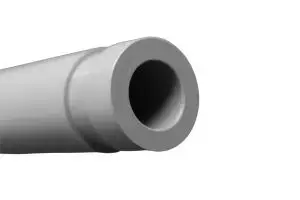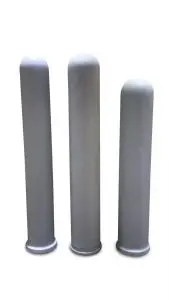Product Description
Sialon, Silicon Nitride, thermocouple protection tubes for high temperature applications up to 1,400 °C

We have two standard diameters sialon ceramic thermocouple tubes sheaths in stock in lengths varying from 150 mm up to 1,600 mm. Tooling cost may apply. Stock items have a standard groove. Gas-tight stainless steel adapters are specially suitable for the thermocouple protection tubes sheaths and heater tubes. Test our new valve adapter for low-pressure die casting machines.
Sialon thermocouple sheaths are available in a range of standard sizes, these are usually available within 2 weeks.
How does a Sialon Ceramic, Silicon Nitride Thermocouple Protection Tube work?
Courtesy of ExplainthatStuff.com
The first person who found that if two ends of a metal were at different temperatures, an electric current would flow through it was German physicist Thomas Seebeck (1770–1831) . That’s one way of stating what’s now known as the Seebeck effect or thermoelectric effect. Seebeck found things got more interesting as he explored further. If he connected the two ends of the metal together, no current flowed; similarly, no current flowed if the two ends of the metal were at the same temperature.
Artwork: The basic idea of a thermocouple: two dissimilar metals (gray curves) are joined together at their two ends. If one end of the thermocouple is placed on something hot (the hot junction) and the other end on something cold (the cold junction), a voltage (potential difference) develops. You can measure it by placing a voltmeter (V) across the two junctions.
Seebeck repeated the experiment with other metals and then tried using two different metals together. Now if the way electricity or heat flows through a metal depends on the material’s inner structure, you can probably see that two different metals will produce different amounts of electricity when they’re heated to the same temperature. So what if you take an equal-length strip of two different metals and join them together at their two ends to make a loop. Next, dip one end (one of the two junctions) in something hot (like a beaker of boiling water) and the other end (the other junction) in something cold. What you find then is that an electric current flows through the loop (which is effectively an electric circuit) and the size of that current is directly related to the difference in temperature between the two junctions.
The key thing to remember about the Seebeck effect is that the size of the voltage or current created depends only on the type of metal (or metals) involved and the temperature difference. You don’t need a junction between different metals to produce a Seebeck effect: only a temperature difference. In practice, however, thermocouples do use metal junctions.
| Material data sheet | Sialon (Si3Al3O3N5) | ||||
Typical Sialon ULTRA™ grades |
ULTRA-001 | ULTRA-002 | ULTRA-003 | ULTRA-004 | |
| Bulk Density | g/cm3 | 3.2 | 3.1 | 3.3 | 3.2 |
| Water Absorption | % | 0 | 0 | 0 | 0 |
| Flexural Strength | MPa | 580 | 900 | 1,020 | 790 |
| Vickers Hardness HV1 | GPa | 13.9 | 12.7 | 15.0 | 13.8 |
| Fracture Toughness (SEPB) | MPam1/2 | 4 ~ 5 | 6 ~ 7 | 7 | 6 ~ 7 |
| Young’s Modulus of Elasticity | GPa | 290 | 270 | 300 | 290 |
| Poisson’s Ratio | – | 0.28 | 0.28 | 0.28 | 0.28 |
| Coefficient of Linear Thermal (40 – 800 °C) Expansion |
×10-6/℃ | 3.2 | 3.4 | 3.3 | 3.5 |
| Thermal Conductivity (20℃) | W/(m・k) | 25 | 23 | 27 | 54 |
| Specific Heat | J/(g・k) | 0.64 | 0.66 | 0.65 | 0.66 |
| Heat Shock Resistance | ℃ | 550 | 800 | 800 | 900 |
| Volume Resistivity (20℃) | Ω・cm | >1014 | >1014 | >1014 | >1014 |













